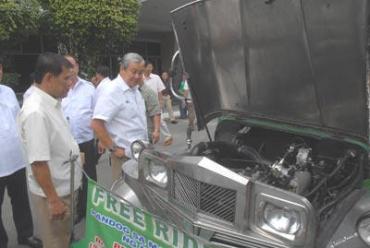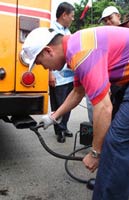Lito Atienza's Blog
DENR SECRETARY LITO ATIENZA: IMPLEMENTING THE CLEAN AIR ACT
1 Comment

Environment and Natural Resources Secretary Lito Atienza (right) inspects the LPG gas compartment of one of four LPG buses that recently arrived in Metro Manila from Xiamen, China. The environment-friendly buses will initially ply the route Fairview-C5 to test the efficiency of their smoke emissions. If found effective, 200 units of the LPG-powered buses will be imported to help boost the government’s effort to improve the air quality in the metropolis. The project is being undertaken jointly by the Office of the President (OP), DENR, Department of Transportation and Communication (DOTC), Land Transportation Franchising and Regulatory Board (LTFRB), Department of Energy (DOE), Board of Investment (BOI) and Department of Trade and Industry (DTI). Briefing Secretary Atienza on the LPG bus is Emmanuel A. Atienza (left), executive vice president of Auto LPG Co., Inc.
The year 2009 marks the 10 th year of the implementation of Republic Act 8749 or the Philippine Clean Air Act of 1999.
Considered a landmark legislation on environment, the Clean Air Act paved the way for the country to put in place concrete measures to reduce emissions of air pollutions, especially in Metro Manila and other highly urbanized cities.
The Clean Air Act is definitely an very important piece of legislation consistent with the constitutional mandate to protect the environment, in this case the air we breathe, while guaranteeing the protection of the people’s right to live in harmony with nature.
And, for the last decade, the Department of Environment and Natural Resources (DENR), which is mandated to spearhead the implementation of the Clean Air Act, has continually made partnerships with other government agencies, local governments, transport and industry sectors as well as the civil society, to ensure that the law’s objective to reduce air emissions are realized.
After 10 years, what have we achieved?
* Based on the monitoring of the DENR, the overall air quality of the country is improving. A reduction of 29% in levels of Total Suspended Particulates (TSP) was achieved and this is partly due to the combined efforts of concerned sectors committed to improve the quality of air that we breathe.
* According to the Department of Health, there has been a significant improvement in blood lead levels among children in Metro Manila since 2000, when the Government started to use unleaded gasoline. In 2003, only 34.6% of study children were found exceeding the US-Center for Disease Control guideline value of 10µg/dl as compared to 90.3% in 2000.
* Improvement in fuel quality was implemented. The Department of Energy has undertaken the following:
o Phase-out of leaded gasoline in January 2001;
o Reduction of benzene and aromatics in unleaded gasoline (ULG) from 4% (by vol.) to 2% and 45% to 35% from Jan. 2000 to Jan. 2003, respectively;
o Reduction of sulfur content of automotive diesel oil ( ADO ) from 0.5% to 0.20% from 1999 to 2001 & further reduction to 0.05% in Jan.2004;
o Reduction of sulfur content of industrial diesel oil (IDO) to 0.30% in Jan.2001;
o Implementation of Memorandum Circular No. 55 requiring all government vehicles to use diesel fuel blended with 1% coco methyl ester starting July 2004;
o Use of 2% biodiesel blend (no more 100% conventional diesel) and availability of E10 effective February 2006 (Bio-Fuels Act).
* Efforts to curb air pollution from motor vehicles were intensified through the Land Transportation Office’s effort to operationalize four Motor Vehicle Inspection Stations (MVIS) under MVIS Phase I, which include: (1) LTO-East Avenue, (2) San Fernando, Pampanga; (3) Las Pinas City; and (4) Cebu City and issued directive to conduct emission testing prior to registration through private emission testing centers (PETCs) starting January 2003. The monitoring of these MVIS and other LTO Emission Testing Centers and PETCs is guided by the DENR-DOTC-DTI Joint Administrative Order in 2003 and this was further revised in December 2007.
* Other efforts to reduce air pollution from new motor vehicles and in-use motorcycles/tricycles are the adoption Euro 2 Type Approval Standards, more stringent emission standards since January 2008 and establishment of hydrocarbon emission standards since June 2003, respectively.
* Anti-smoke belching operations were likewise strengthened with the support of the Metro Manila Development Authority and local government operations. Several programs were also launched to increase participation in anti-smoke belching activities, namely, the SMOKE–FREE EDSA (October 2003) and the LINIS HANGIN PROGRAM (November 2004 up to present) by DENR.
* The use of alternative fuels was also promoted by concerned agencies and this led to:
* conversion of gasoline-fed taxis to liquid petroleum gas;
* introduction of new compressed natural gas (CNG) buses pursuant to Executive Order No. 290 [Natural Gas Vehicle Program for Public Transport (NGVPPT)] . To date, a total of 30 new CNG buses are plying the route of Batangas/Sta. Cruz-EDSA-Cubao & vice versa on a commercial scale.
* In mid-2006, motorcycle manufacturers voluntarily phased-out two-stroke motorcycle engines in support of the Clean Air Act.
* Efforts to abate air pollution from industrial sources and establishments were intensified through the accreditation of third party source emission testing firms to conduct compliance testing prior to operation. Likewise, major sources of air pollution were directed to install continuous emission monitoring systems to monitor their compliance to emission standards at all times.
What’s left to do?
Despite the winnings, however, there remains huge task to do to assure the people of improved air quality to breathe. The ambient air quality monitoring being conducted by the DENR indicates of improving air quality. But still the air pollution level is high and unhealthy especially among the vulnerable sectors like the young, the old and the sickly.
Based on information collected from national and local government agencies, through Clean Air InitiativeI-Asia Network in 2003, Manila ranks 7th among twelve (12) cities in the region with dirty air, in terms of total suspended particulates (TSP).
And in the face of global warming and climate change, more work needs to be done especially since air pollution and climate change are strongly linked to each other. Bringing the level of air pollution down to safe levels can cut on greenhouse gas emissions.
Local government units share the responsibility in managing air quality within their territorial jurisdiction. The local chief executives are members of the airshed governing boards. They also play key roles in carrying out the other provisions of the Clean Air Act.
Among other things, the DENR is urging all LGUs to:
* Strictly implement the ban on smoking inside public places
* Designate an Environment and Natural Resources Office in every province, city, municipality
* Implement air quality standards set by the Governing Board
* Prepare and develop, with the assistance from the Department, an action plan consistent with the Integrated Air Quality Framework to attain and maintain the ambient air quality standards within their respective airsheds
* Prepare and implement a program and other measures including relocation, whenever necessary, to protect health and welfare of residents in the area in during extreme air pollution events.
The steady brown haze that blankets major cities in the country is something that cannot be ignored. Now is the time to act and with increasing steps over time, we can fight air pollution and give next generations of Filipinos a cleaner and healthier future.
Atienza orders reactivation of DENR anti-smoke belching units
2 Comments

Department of Environment and Natural Resources (DENR) Lito Atienza (right) looks at the engine of the liquefied petroleum gas-fueled jeepney at the DENR compound in Quezon City. Three motor vehicles, one turbo-jet type air-conditioned jeepney (Isuzu 4HFI) and two LPG-fueled jeepneys (models 4Y2.4 and 3RZ2.7), were presented by past Filipino Inventors Society (FIS) president Orlando Marquez (left) to Atienza to promote his (Marquez’s) inventions to help the government in its program to improve the air quality in Metro Manila and other urban centers nationwide. The three vehicles were said to be compliant with the DENR emission standards under the Philippine Clean Air Act of 1999.
I have directed the Environmental Management Bureau (EMB) to reactivate its anti-smoke belching units in an effort to lower the air pollution level in Metro Manila within the healthful standards of the World Health Organization (WHO).
I likewise urge the Land Transportation Office and the Department of Trade and Industry to tighten their control on private emission testing centers to put a stop to what is called a ‘no show certification’ in order to minimize the volume of smoke belching vehicles being registered.
Let’s put a stop to the nefarious activity of issuing certificates of emission compliance without actual testing of vehicles. This is where corruption starts because vehicles that have not met the emission standards are eventually registered using the emission certificate as basis. It makes no sense at all how a lot of public utility vehicles (trucks, buses, tricycles) and trucks are able to secure certificates of emission compliance when it is common knowledge that most of these vehicles are the main source of toxic emissions while plying Metro Manila’s roads.
Private testing centers should comply with regulations, or they will be made accountable under the Philippine Clean Air Act (Republic Act No. 8749).
I also ordered the heightened coordination among the LTO, Land Transportation Franchise Regulatory Board (LTFRB), and local government units in Metro Manila to get involved in the anti-smoke belching campaign.
The DENR-ASBU’s reactivation will see action starting on August 1 along the stretch of the Epifanio delos Santos Avenue (EDSA) with four apprehending teams and along the 12.4 kilometer Commonwealth Avenue in Quezon City.
I am also calling on local government officials in Metro Manila’s 17 cities to intensify their offensive against smoke-belching vehicles in an effort to bring air pollution levels in Metro Manila within the WHO standard by 2010.
2008 records from the Environmental Management Bureau’s ambient air monitoring stations are as follows:
MRT Pasay- Total Suspended Particles: 272 micrograms per normal cubic meter
Makati- Total Suspended Particles: 310 micrograms per normal cubic meter
East Avenue- Total Suspended Particles: 370 micrograms per normal cubic meter
Valenzuela- Total Suspended Particles: 418 micrograms per normal cubic meter
Marikina- Total Suspended Particles: 240 micrograms per normal cubic meter
WHO set the ambient air quality guideline value for Total Suspended Particulate (TSP) at 90 micrograms per normal cubic meter (ug/Ncm ).

The fight against smoke belching vehicles in Metro Manila will set the tone of the overall campaign of the effort stressing that winning the air battle in Metro Manila means that we can win it anywhere else.
The renewed campaign by the DENR will run parallel to anti-smoke belching campaigns being embarked by local government units especially those actively running after smoke-belching vehicles passing through their jurisdictions like Makati City which maintains five ASBUs, Pasig City (4), Quezon City (2), Muntilupa (2), and Manila (1).



